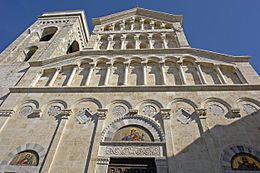
 The “Poetto” (Poettu in Sardinian) is the main beach of Cagliari that stretches for about eight kilometers, from Sella del Diavolo until the coast of St. Helens. The Poetto is also the district located in the western section of the area between the beach and the salt marshes of Molentargius.
The “Poetto” (Poettu in Sardinian) is the main beach of Cagliari that stretches for about eight kilometers, from Sella del Diavolo until the coast of St. Helens. The Poetto is also the district located in the western section of the area between the beach and the salt marshes of Molentargius.
The name of the beach is thought to derive from an Aragonese tower called “Poet”, which can be observed even today over the Sella del Diavolo. Another theory is that it derives from the Catalan pohuet (cockpit), in reference to the numerous wells and cisterns for rainwater retention scattered on the Sella del Diavolo. Moreover, most likely, the term could come from Spanish puerto ( “port”) to indicate the port of Marina Piccola near the Sella del Diavolo. The town would be called by Cagliari pue (r) to, pue (r) you or PUE (r) TTU, as it is known today. After the Spanish domination, the Piedmontese italianizzarono many terms derived from Spanish and “puettu” became Poetto in the language of the realm.
Before 1900 the Poetto was completely in the district of the city of St. Helens and was not particularly popular with the people of Cagliari who preferred the western section of the Gulf, with the towns of Sa Perdixedda and Georgie. It was in the early decades of the twentieth century that the population began to appreciate the white dunes of Poetto and began to arise the first bathing establishments (the “Lido” and “D’Aquila”), kiosks for refreshments and during the Fascist period a summer camp located in a three-storey building on the beach (this will then be transformed into a hospital after the war and later abandoned). Imitating the first cabins of Lido arose even the huts, colorful wooden buildings halfway between the locker room and the tiny house by the sea, which were removed entirely in 1986 for health and hygiene reasons.
Sella del Diavolo and Poetto beach
The study of the 1989 Mediterranean Survey and Service MSS S.p.A. erosion Poetto, through a series of surveys made it possible to see that the huge degradation dell’arenile Cagliari began the 50s with the reconstruction that led to massive withdrawals of sand; in 1997 and 1999 they were carried out by the same company of the updates to the study which confirmed the erosion trends, and identified what causes the presence of the degradation of the coastal road, the increased wave action due to the disappearance of the oceanic Posidonia, and the construction of settlements and arms to the Lido and D’Aquila sea of huts and houses.
Poetto aerial view.
To overcome the disappearance of the Cagliari beach side you tried a nourishment in 2002 through a system of dredgers, the sand has been drawn to a few hundred meters from the shore instead of the previously chosen location several miles from the beach, thus defeating the good plans to bring the Poetto to its original beauty and size. In fact the result has proved shocking: the fine white sand of a time has been replaced by a completely different mix color and size, containing not only sand but also fragments of shells and marine concretions. A distance of time the situation is not improved; Moreover also that the section quartese, at first remained intact after a few years began to have the same problems due to the removal of sand by wind, of men and of course sea.
In January 2012, for the first time after the operation of nourishment, the beach recovers meters, even ten at some points, as reported by the Urban Center in Cagliari.Tuttavia, in 2013, the current erosive force, added to the mismanagement and missed studies on erosion processes, reported the situation before 2002.













